The potassium channel Ether à go-go is a novel prognostic factor with functional relevance in acute myeloid leukemia
- PMID: 20105281
- PMCID: PMC2835655
- DOI: 10.1186/1476-4598-9-18
The potassium channel Ether à go-go is a novel prognostic factor with functional relevance in acute myeloid leukemia
Abstract
Background: The voltage-gated potassium channel hEag1 (KV10.1) has been related to cancer biology. The physiological expression of the human channel is restricted to the brain but it is frequently and abundantly expressed in many solid tumors, thereby making it a promising target for a specific diagnosis and therapy. Because chronic lymphatic leukemia has been described not to express hEag1, it has been assumed that the channel is not expressed in hematopoietic neoplasms in general.
Results: Here we show that this assumption is not correct, because the channel is up-regulated in myelodysplastic syndromes, chronic myeloid leukemia and almost half of the tested acute myeloid leukemias in a subtype-dependent fashion. Most interestingly, channel expression strongly correlated with increasing age, higher relapse rates and a significantly shorter overall survival. Multivariate Cox regression analysis revealed hEag1 expression levels in AML as an independent predictive factor for reduced disease-free and overall survival; such an association had not been reported before. As a functional correlate, specific hEag1 blockade inhibited the proliferation and migration of several AML cell lines and primary cultured AML cells in vitro.
Conclusion: Our observations implicate hEag1 as novel target for diagnostic, prognostic and/or therapeutic approaches in AML.
Figures

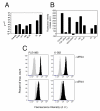

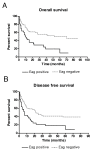

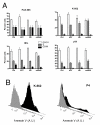
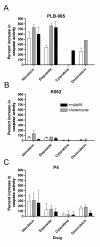
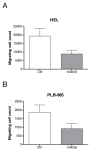
Similar articles
-
Frequent aberrant expression of the human ether à go-go (hEAG1) potassium channel in head and neck cancer: pathobiological mechanisms and clinical implications.J Mol Med (Berl). 2012 Oct;90(10):1173-84. doi: 10.1007/s00109-012-0893-0. Epub 2012 Mar 31. J Mol Med (Berl). 2012. PMID: 22466864
-
Overexpression of potassium channel ether à go-go in human osteosarcoma.Neoplasma. 2012;59(2):207-15. doi: 10.4149/neo_2012_027. Neoplasma. 2012. PMID: 22248279
-
Human ether-à-go-go gene potassium channels are regulated by EGFR tyrosine kinase.Biochim Biophys Acta. 2012 Feb;1823(2):282-9. doi: 10.1016/j.bbamcr.2011.10.010. Epub 2011 Oct 28. Biochim Biophys Acta. 2012. PMID: 22061963
-
Kv10.1 potassium channel: from the brain to the tumors.Biochem Cell Biol. 2017 Oct;95(5):531-536. doi: 10.1139/bcb-2017-0062. Epub 2017 Jul 14. Biochem Cell Biol. 2017. PMID: 28708947 Review.
-
Eag1 K+ Channel: Endogenous Regulation and Functions in Nervous System.Oxid Med Cell Longev. 2017;2017:7371010. doi: 10.1155/2017/7371010. Epub 2017 Mar 6. Oxid Med Cell Longev. 2017. PMID: 28367272 Free PMC article. Review.
Cited by
-
Astemizole-based anticancer therapy for hepatocellular carcinoma (HCC), and Eag1 channels as potential early-stage markers of HCC.Tumour Biol. 2015 Aug;36(8):6149-58. doi: 10.1007/s13277-015-3299-0. Epub 2015 Mar 18. Tumour Biol. 2015. PMID: 25783527
-
Altered expression and functional role of ion channels in leukemia: bench to bedside.Clin Transl Oncol. 2020 Mar;22(3):283-293. doi: 10.1007/s12094-019-02147-2. Epub 2019 Jul 6. Clin Transl Oncol. 2020. PMID: 31280433 Review.
-
PIST (GOPC) modulates the oncogenic voltage-gated potassium channel KV10.1.Front Physiol. 2013 Aug 14;4:201. doi: 10.3389/fphys.2013.00201. eCollection 2013. Front Physiol. 2013. PMID: 23966943 Free PMC article.
-
Analysis of the expression of Kv10.1 potassium channel in patients with brain metastases and glioblastoma multiforme: impact on survival.BMC Cancer. 2015 Nov 3;15:839. doi: 10.1186/s12885-015-1848-y. BMC Cancer. 2015. PMID: 26530050 Free PMC article.
-
Prognostic significance of the TREK-1 K2P potassium channels in prostate cancer.Oncotarget. 2015 Jul 30;6(21):18460-8. doi: 10.18632/oncotarget.3782. Oncotarget. 2015. PMID: 25962960 Free PMC article.
References
-
- Muñoz L, Nomdedeu JF, Villamor N, Guardia R, Colomer D, Ribera JM, Torres JP, Berlanga JJ, Fernández C, Llorente A. Acute myeloid leukemia with MLL rearrangements: clinicobiological features, prognostic impact and value of flow cytometry in the detection of residual leukemic cells. Leukemia. 2003;17:76–82. doi: 10.1038/sj.leu.2402708. - DOI - PubMed
-
- Zwaan CM, Meshinchi S, Radich JP, Veerman AJ, Huismans DR, Munske L, Podleschny M, Hahlen K, Pieters R, Zimmermann M. FLT3 internal tandem duplication in 234 children with acute myeloid leukemia: prognostic significance and relation to cellular drug resistance. Blood. 2003;102:2387–2394. doi: 10.1182/blood-2002-12-3627. - DOI - PubMed
-
- Ostendorf P, Seeber S. Hämatologie/Onkologie. Munich: Urban & Fischer Verlag; 1997.
MeSH terms
Substances
LinkOut - more resources
Full Text Sources
Medical
Research Materials

